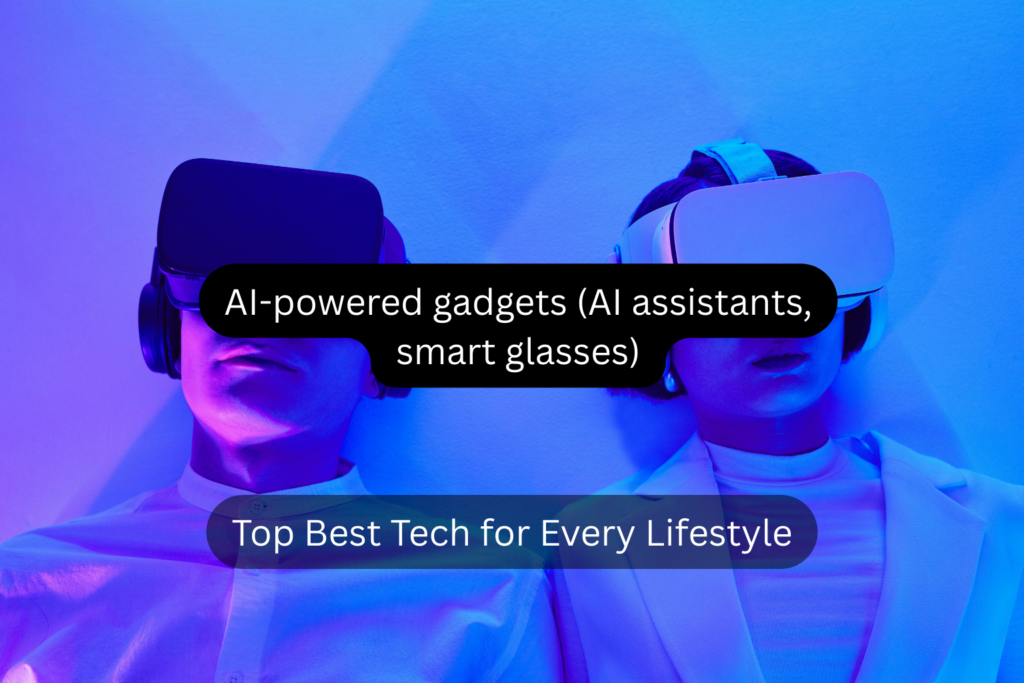Introduction to AI-powered Gadgets
Technology is evolving at lightning speed, and among the most exciting innovations are AI-powered gadgets. From voice-controlled assistants to futuristic smart glasses, these devices are reshaping how we interact with the digital world. Whether you’re asking Alexa to dim the lights, using Siri to send a quick message, or navigating with AI-driven smart glasses, artificial intelligence is no longer just a buzzword—it’s becoming a trusted companion in daily life.
In this article, we’ll explore AI assistants and smart glasses in depth, uncovering their benefits, challenges, applications, and what the future might hold for these transformative gadgets.
The Rise of AI Assistants
What Are AI Assistants?
AI assistants are software-powered digital helpers designed to process voice commands, understand natural language, and perform tasks on our behalf. They act as a bridge between humans and technology, making interactions faster, simpler, and more intuitive.
Popular Examples (Alexa, Google Assistant, Siri, ChatGPT)
The market is dominated by familiar names:
- Amazon Alexa – Great for smart home integration.
- Google Assistant – Known for accurate search and navigation.
- Apple’s Siri – Seamlessly integrated with Apple’s ecosystem.
- ChatGPT-powered assistants – Offering conversational depth and problem-solving skills.
How AI Assistants Are Shaping Everyday Life
From setting reminders and booking appointments to controlling smart homes and even providing companionship, AI assistants are becoming indispensable. They’re transforming how we multitask, making life more efficient and connected.
Smart Glasses: Blending AI With Augmented Reality
Evolution of Smart Glasses Technology
Smart glasses have evolved from bulky, experimental prototypes to sleek, fashionable wearables. What once seemed futuristic is now within reach, thanks to AI integration.
AI-Powered Features (Voice Commands, Real-time Translation, Navigation)
Modern smart glasses come packed with features such as:
- Voice command controls for hands-free interaction.
- Real-time language translation for travelers and professionals.
- Augmented reality navigation that overlays directions right onto your field of view.
Top Smart Glasses in 2025
Some of the most exciting options include:
- Meta’s AR Glasses – Offering immersive social interactions.
- Ray-Ban Meta Smart Glasses – Stylish yet functional.
- Apple Vision Pro Lite (expected) – Bridging entertainment and productivity.
Key Benefits of AI-powered Gadgets
Increased Productivity
AI-powered gadgets streamline tasks, helping people manage time and responsibilities effectively.
Improved Accessibility for All Users
Visually impaired individuals, for instance, benefit greatly from AI glasses that describe surroundings and read text aloud.
Challenges and Concerns
Privacy and Data Security Issues
One of the biggest concerns with AI-powered gadgets is data privacy. Devices like AI assistants and smart glasses often require access to sensitive information—such as location, voice data, and personal preferences. If not properly secured, this data could be exploited by hackers or misused by corporations.
Dependency on AI Systems
While AI makes life easier, over-reliance can be problematic. Constantly depending on AI for decision-making may reduce critical thinking skills and create an unhealthy dependency.
Cost and Accessibility Barriers
Although AI gadgets are becoming more mainstream, high costs remain a barrier for many people. Smart glasses and advanced assistants can be expensive, limiting accessibility to wealthier demographics.
Real-world Applications of AI-powered Gadgets
In the Workplace (Meetings, Scheduling, Automation)
AI assistants simplify work by managing calendars, setting reminders, transcribing meetings, and even summarizing emails. Smart glasses can provide live data during presentations, enhancing productivity and collaboration.
In Healthcare (Assisting Doctors, Helping Patients)
Doctors are already using AI-powered gadgets to access medical records instantly, assist in surgeries, and monitor patients remotely. Smart glasses allow surgeons to overlay critical data directly onto their field of vision.
In Education (Smart Learning Tools)
Students benefit from AI assistants acting as study partners, providing instant explanations. Smart glasses can enhance immersive learning with AR, making history lessons or science experiments more engaging.
Future Trends of AI Assistants and Smart Glasses
Integration with IoT Devices
The future points toward seamless integration, where AI assistants and smart glasses connect effortlessly with smart homes, cars, and workplaces.
Advancements in Natural Language Processing
As AI becomes better at understanding context, conversations with AI assistants will feel more natural and human-like.
Smarter AR Experiences with AI
Future smart glasses will likely include advanced AR overlays, such as real-time object recognition, health monitoring, and AI-driven navigation.
Comparison: AI Assistants vs Smart Glasses
Similarities
- Both enhance productivity.
- Both rely on AI-driven personalization.
- Both connect with other smart devices.
Differences
- AI Assistants are mainly voice-activated and stationary.
- Smart Glasses offer visual + interactive AR experiences on the go.
Which Gadget Fits Your Needs?
- Choose AI Assistants if you need a home/work hub for scheduling, automation, and tasks.
- Choose Smart Glasses if you value mobility, immersive AR experiences, and real-time information overlays.
Expert Predictions for the Next 5 Years
Experts believe that AI-powered gadgets will become more affordable, stylish, and integrated into daily life. AI assistants will evolve into personal digital companions, while smart glasses may become as common as smartphones.
FAQs About AI-powered Gadgets
Q1: Are AI assistants always listening?
Yes, but only after detecting a “wake word.” However, some privacy concerns remain, so it’s wise to review your device settings.
Q2: Can smart glasses replace smartphones?
Not yet. While smart glasses can handle calls, navigation, and notifications, smartphones still offer a broader range of functions.
Q3: Do AI-powered gadgets require constant internet access?
Most do, since they rely on cloud-based AI models. However, offline features are expanding.
Q4: Are AI gadgets safe for children?
Yes, with parental controls. AI assistants can help with learning, but supervision is essential.
Q5: How expensive are smart glasses today?
Prices range from $300 to $2000, depending on features and brand.
Q6: Will AI assistants become more “human-like”?
Absolutely. With better natural language processing, AI assistants are expected to sound more conversational and emotionally intelligent.
Conclusion: Embracing the AI-powered Future
AI-powered gadgets like AI assistants and smart glasses are no longer futuristic dreams—they’re shaping the way we live, work, and interact. While concerns about privacy and accessibility remain, the benefits in productivity, connectivity, and innovation are undeniable.
As these technologies evolve, one thing is clear: AI gadgets are here to stay, and they’ll become an integral part of our daily lives in the years to come.

